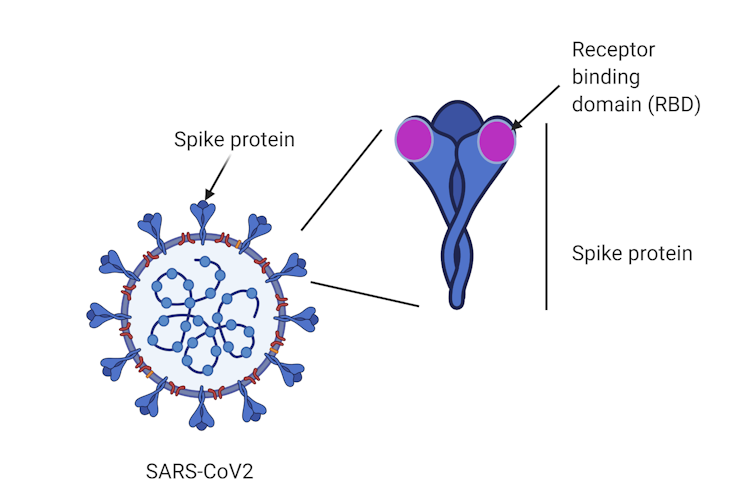The three candidates to share this funding are:
Let’s take a look at these different approaches.
- a targeted subunit protein vaccine, developed by the Doherty Institute
- an mRNA vaccine, developed by the Monash Institute of Pharmaceutical Sciences (MIPS)
- a needle-free DNA vaccine, developed by the University of Sydney.
Read more: From adenoviruses to RNA: the pros and cons of different COVID vaccine technologies
Targeting the tip
I’m part of the Monash team working with scientists at the Doherty Institute on both the protein vaccine and the mRNA vaccine. Although we initially developed these vaccine candidates separately, they target a similar part of the virus — so we’ve now joined forces to further develop the two together.
Until now, vaccine candidates, such as those developed by the University of Queensland and the University of Oxford, have generally used the entire spike protein as a target. The spike is a large protein found on the surface of SARS-CoV-2, the virus that causes COVID-19.
A region at the tip of the spike called the “receptor-binding domain” enables the virus to establish itself by binding to our cells and causing infection.
Instead of vaccinating against the “whole” spike protein, our approach is unique in that it uses the receptor-binding domain tip.
The subunit protein vaccine contains the receptor-binding domain from SARS-CoV-2 as the antigen, or target. Exposing our immune system to this protein is intended to create antibodies that generate immunity against this part of the virus, protecting us if we encounter SARS-CoV-2 in the future.
For the mRNA vaccine, rather than injecting the protein itself, a short piece of the genetic material from the virus (mRNA) provides a blueprint to make the receptor-binding domain. So this vaccine also targets the receptor-binding domain to induce an immune response, although the process is different.
The subunit protein vaccine and the mRNA vaccine both target the receptor-binding domain, a region at the tip of the spike protein. Created with BioRender.com, Author provided
We’re exploring the two vaccine options simultaneously. One may prevail as the most promising candidate.
It’s also possible ONE CANDIDATE might be the PRIMARY VACCINE and the other could serve as a booster — it’s still early to tell.
The funding we’ve received will support the development and manufacturing of the two candidates with the intention to enter phase 1 human trials next year if the vaccines prove promising in mice and monkeys. Early results are encouraging.
Notably, both of these vaccines can be produced and manufactured rapidly. For example, within three weeks of receiving the genetic sequence of SARS-CoV-2, we were able to produce three mRNA vaccine candidates.
This flexibility of the Doherty/MIPS approach will be particularly important if COVID-19 mutates into a new strain, and could also be useful for vaccine development in future pandemics.
Read more: The Oxford deal is welcome, but remember the vaccine hasn't been proven to work yet
A needle-free DNA vaccine
The third COVID-19 vaccine candidate uses DNA technology. A DNA-based vaccine works in a similar way to an mRNA vaccine. By producing the viral antigen inside us, mRNA and DNA vaccines teach our immune system to recognise the antigen should the virus invade in the future.
DNA vaccines have been under development for roughly the past 20 years. While they’re safe, their effectiveness remains in question. So the University of Sydney scientists are rethinking the way they’re delivered.
The previous DNA vaccines relied on a standard needle and syringe delivery, but the University of Sydney’s innovative approach uses a needle-free device. This method will deliver the vaccine using a “liquid jet” to penetrate our skin.
Needle-free delivery improves the distribution of the DNA vaccine deeper into the injected site, which can improve the vaccine’s effectiveness.
B
- Forums
- ASX - By Stock
- BIT
- ONE CANDIDATE might be the PRIMARY VACCINE
ONE CANDIDATE might be the PRIMARY VACCINE
-
- There are more pages in this discussion • 7 more messages in this thread...
You’re viewing a single post only. To view the entire thread just sign in or Join Now (FREE)
Featured News
Add BIT (ASX) to my watchlist
 (20min delay) (20min delay)
|
|||||
|
Last
3.8¢ |
Change
0.001(2.70%) |
Mkt cap ! $34.28M | |||
| Open | High | Low | Value | Volume |
| 3.7¢ | 4.0¢ | 3.7¢ | $68.85K | 1.794M |
Buyers (Bids)
| No. | Vol. | Price($) |
|---|---|---|
| 2 | 150000 | 3.7¢ |
Sellers (Offers)
| Price($) | Vol. | No. |
|---|---|---|
| 4.0¢ | 349950 | 3 |
View Market Depth
| No. | Vol. | Price($) |
|---|---|---|
| 2 | 150000 | 0.037 |
| 5 | 415000 | 0.036 |
| 5 | 724214 | 0.035 |
| 2 | 106000 | 0.033 |
| 3 | 91250 | 0.032 |
| Price($) | Vol. | No. |
|---|---|---|
| 0.040 | 299950 | 2 |
| 0.041 | 144000 | 2 |
| 0.042 | 117600 | 1 |
| 0.043 | 102000 | 1 |
| 0.045 | 120000 | 1 |
| Last trade - 15.10pm 28/06/2024 (20 minute delay) ? |
Featured News
| BIT (ASX) Chart |
The Watchlist
LU7
LITHIUM UNIVERSE LIMITED
Alex Hanly, CEO
Alex Hanly
CEO
SPONSORED BY The Market Online










